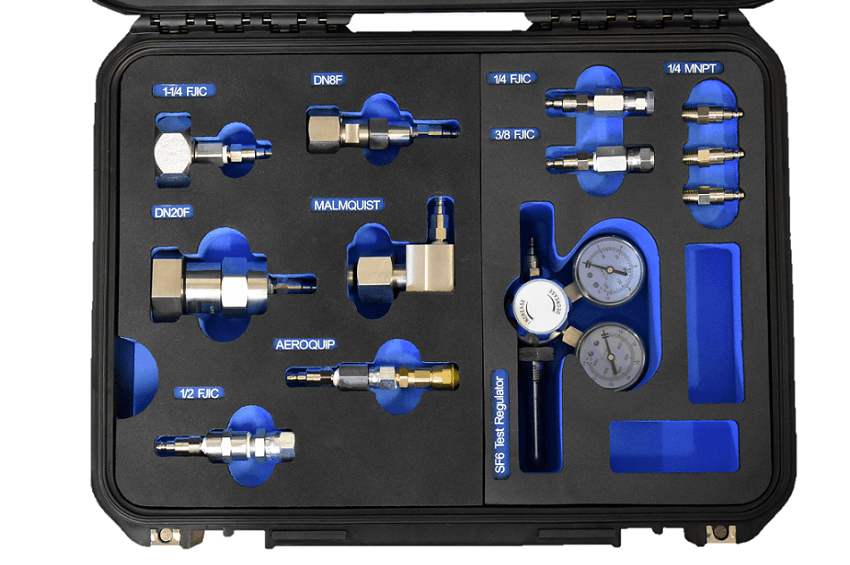SF6 Analyzer Fittings Kit
Our SF6 Gas Analyzer Fittings Adapter Kit is designed to work with the most popular SF6 Analyzers and North American SF6 breaker connections. Our fittings are precisely manufactured and imported from Italy. The case is a rugged and waterproof SKB I-Series case with dual locking latches.
Typically Ships Within: 3-5 Days
$2,699.99
SF6 Analyzer Fittings Kit Features:
- Custom Foam cutouts and labels
- Dual locking, rugged waterproof SKB case
- Italian laser cut SF6 fittings
- Included SF6 Regulator
Adapters Included:
- RECTUS 21 Male Quick Disconnect to ¼” Female JIC
- RECTUS 21 Male Quick Disconnect to 3/8” Female JIC
- RECTUS 21 Male Quick Disconnect to ½” Female JIC
- RECTUS 21 Male Quick Disconnect to 1 1/4” Female JIC
- RECTUS 21 Male Quick Disconnect to 1/4” Male NPT (3pcs)
- RECTUS 21 Male Quick Disconnect to DN20 Female
- RECTUS 21 Male Quick Disconnect to Aeroquip
- RECTUS 21 Male Quick Disconnect to Malmquist Female
- RECTUS 21 Male Quick Disconnect DN8 Female
- SF6 Sampling Regulator with RECTUS 21M QD
What SF6 analyzer can be used with this?
- FLEX – Modular SF6 Analyzer
- RH Sytems 973 Analyzer
- Dilo Multi Analyzer
- SMC Rapidox
- Wika SF6 Gas Analyzer
- Any other manufacturers of an SF6 Analyzer with a standard rectus type 21 connection
Why an adapter kit?
Our SF6 Analyzer Fittings Kit helps eliminates constantly searching for the right fitting when hooking up to a SF6 gas circuit breaker. To learn more about proper gas handling techniques, check out our blog.
What types of fittings are common in the field?
Recuts Type 21:
This fitting is the type of connection that is commonly used with SF6 Gas Analyzers, especially in the field. It has a self sealing head that is spring loaded, and is considered a “Quick Connect”.
Tongue and Groove:
This type of fitting is the commonly used in the field and has become an industry standard. The two sizes typically seen are DN8 & DN20. The 8 & 20 size designations are based on the ID of the fitting. These fittings work by utilizing a metal to metal seal when tightened. The tongue or raised portion can be found inside the female valve and the groove is on the male side. These types of fittings do well when vibration is present, under vacuum or positive pressure, and can remain tight under a large range of temperatures. The nice thing about these is that they cannot be over tightened and can be reused indefinitely, but the sealing surfaces must be kept clean.
NPT:
This fitting establishes a seal through the metal-to-metal wedging that occurs when this thread is tightened. These connections require a liquid thread sealant or Teflon tape to seal properly. Once these are assembled it is best to leave them together as each time they are loosened & tighten it wears out the threads and it’s means of sealing. The good news is they are readily available, so it’s easy to replace one should it develop a leak.
Parallel:
These threads are sealed either at the “face” or top of the threaded portion below the hex bolt. Alternatively, some types seal at the “nose” or bottom of the threads opposite hex bolt. This is accomplished using an O-ring or bonded washer which can be replaced over time. These do not require a thread sealant. This type of fitting is a good choice for applications which must be taken apart and put back together, since only the gasket or washer needs to be replaced should a leak develop. It is also important to keep the sealing surfaces clean and undamaged.
Flare Fittings
These compression type fittings are sealed through direct metal to metal contact or with the use of a copper gasket between the two opposing flared surfaces. These are commonly use for building hoses and are not intended for frequent reuse as the sealing surfaces will begin to wear and become concaved causing leakage. They are readily available and easily replaced should this happen though.
Keep in mind that these fittings are available in the JIC (37 degree) and SAE (45 degree) versions that are not interchangeable. Many older circuit breakers use JIC as a gas connection port. SAE are more common in the refrigeration industry but can be found on some MV switchgear.


